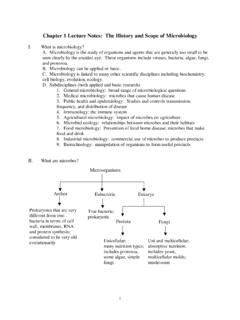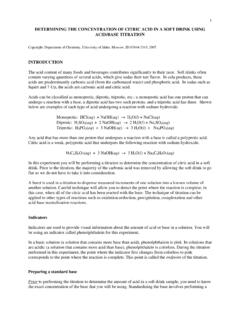Transcription of Determination of an Unknown Diprotic Acid by Titration Dr ...
1 Chemistry 141 Determination of an Unknown Diprotic acid by Titration Dr. Abrash Q: What is the purpose of today s experiment? Today you re going to do your second Titration experiment of the semester. In the first Titration experiment you used an indicator to find the endpoint the point at which your original solution, either HCl or NaOH, was completely reacted. In this experiment we re going to do a Titration of a weak Diprotic acid (an Unknown ) by a strong base (NaOH). We re going to use the information we obtain from our Titration curve to determine the identity of the Unknown acid . Q: Why are we doing a Titration AGAIN? First, instead of using an indicator to tell use when the Titration reaches the endpoint, we will be using a pH meter to follow the Titration .
2 PH meters are far more powerful analytical tools than indicators. They allow us to continuously monitor the pH as a function of acid or base added to our solution, which can be plotted as a so-called Titration curve. Q: What does a Titration curve tell us that an indicator can t? The Titration curve has several advantages over the indicator. First, since it is designed to continue past the endpoint, the problem that we had in the first experiment of passing the endpoint is nonexistent. Second, analysis of the curve allows for more precise Determination of the endpoint. Third, indicators work at only specific pH s so careful selection is required to match the indicator to the endpoint for your acid or base.
3 In contrast, a pH meter can determine an endpoint for any acid base combination. Finally, analysis of the Titration curve can show us if we have a strong acid , strong base, weak acid , or weak base; can show us the buffer region for the system if it exists, and can distinguish easily between monoprotic and polyprotic acids. It also allows us to find Ka for a weak acid or Kb for a weak base. Q: Any other reasons? In addition to giving you the opportunity to generate a Titration curve manually, you ll get the opportunity to try using an automated autotitrator, to see the difference in the results, and also the differences in the way that the data can be presented.
4 Q: You said we re going to use a pH meter to measure pH as a function of acid or base added. What is pH? pH is defined as the log [H3O+]. It is a convenient measure of wide range of acid concentrations. Q: What happens during a Titration of a weak acid with a strong base? A reasonable view is that as the strong base is added bit by bit to the acid solution, it reacts with the weak acid , so that the strong base is completely consumed. What is left in solution then is a mixture of the weak acid , HA, and its conjugate base, A-. At this stage the pH of the solution is the pH characteristic of this mixture of conjugate acid and conjugate base.
5 Q: How do you calculated the pH of a mixture of a weak acid and it s conjugate base? For the case where the ratio of conjugage base to conjugate acid is between 1:10 and 10:1, the calculation is simple. It is based on the equation used to define the Ka of the acid : 3aHOAKHA, where Ka is the acid dissociation constant, [HA] represents a weak acid , and A- represents its conjugate base. Since pH is related to concentration of 3HO, we solve this for 3 HOto get: 3aHAHOKA Taking the log of both sides and multiplying by -1 yields logaHApHpKA where the pKa is defined as log Ka. Q: What s so special about this range of ratios between 10:1 and 1:10?
6 When a weak acid and its conjugate base are present in this range of ratios, adding strong base changes the pH very slowly. A solution like this, which is resistant to rapid pH change, is called a buffer. Q: What happens as we continue to add the strong base? To our solution? The weak acid continues to be converted to its conjugate base. This continues until the number of moles of strong base added to the mixture is equal to the initial number of moles of the weak acid at which point the acid is completely converted to the conjugate base, A-. This is the equivalence point. After this, the addition of more [OH-] simply increases the pH, and it steadily increases toward the pH of the strong base solution.
7 Q: What are the features of a Titration curve when a weak acid is titrated with a strong base? [Draw a typical curve] In this case there is a small increase in pH followed by a plateau region called a buffer region in which the pH increases slowly. Near the equivalence point the pH rapidly increases. Past the equivalence point the rate of increase levels off until the pH approaches that of the strong base. Q: You said at the beginning that the acid we re titrating is polyprotic. What s a polyprotic acid ? A polyprotic acid is one with more than one acidic proton. Q: What is different about the Titration behavior if the acid is polyprotic?
8 There are two cases we need to consider here. If the acidic proton has strong acid characteristics ( , is completely dissociated in solution), the curve looks initially like a strong acid Titration , but after the equivalence point, a buffer region occurs followed by a second rapid increase toward the equivalence point. If the first proton has weak acid characteristics, the normal weak acid curve is followed by a second buffer region and second equivalence point before the pH approaches that of the strong base. Q: How do we use the Titration curve to identify our Unknown ? Usually to identify an Unknown acid , it is sufficient to know the pKa (or in this case pKas), and the molar mass.
9 Q: How do we determine the pKa from our Titration curves? If we look at the equation for pH above, we can see that when the concentrations of the weak acid and weak base are equal the log term becomes zero and pH = pKa. This occurs in the middle of the buffer region. This is at the volume of base added exactly halfway to the equivalence point. Therefore the pH at this point is the pKa of the weak acid . Q: How do we determine the equivalence point? We use a graphical technique, illustrated on page 111 of your lab manual. The steps are: a) Extend the nearly level regions before and after the equivalence points with a dotted line. b) Draw a straight line from the top dotted line to the bottom dotted line so that the line crosses the middle of the steep part of your Titration curve.
10 This should be done so that the shaded area enclosed on each side of the line is as close as possible to equal. c) The equivalence point is the point where the straight line crosses the Titration curve. Q: How do I calculate the molar mass of my Unknown ? At the equivalence point (or first equivalence point for a polyprotic compound) you know the number of moles of your substance since mol Unknown = mol base added. You determine the number of mols using mol base = vol base at equiv pt x M base. Dividing your measured mass by the number of moles should give you the molar mass. Q: Do you have any experimental tips for us? Sure: 1) Regarding the pH Meter: Please don t use the electrode of the pH meter to stir your solutions.










